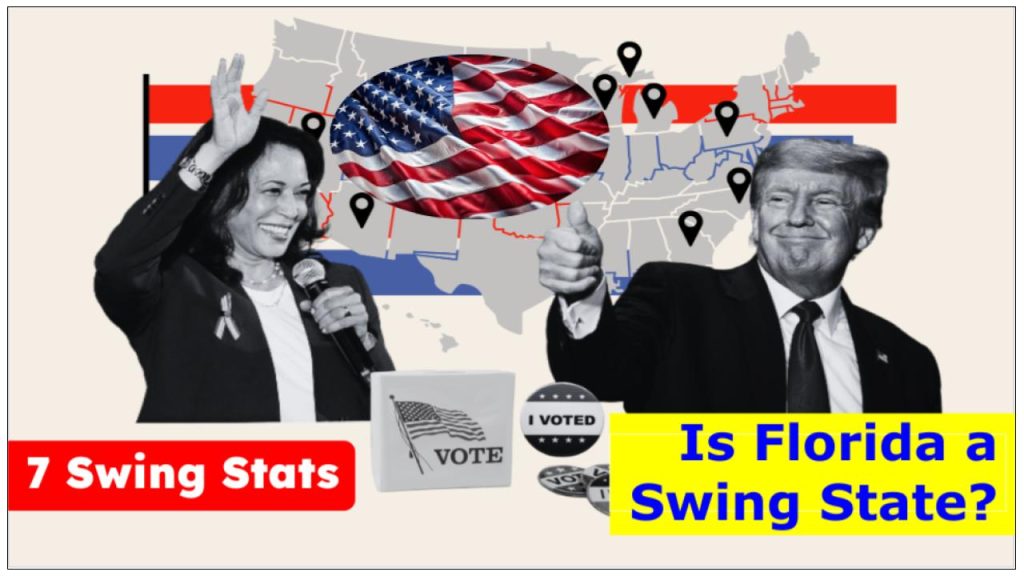7 Swing Stats: Swing states, also known as battleground states, are pivotal in U.S. presidential elections. These states, where both the Democratic and Republican parties have strong support, often witness close races that can tip either way. Swing states carry immense influence over election outcomes due to their unpredictability and the large number of electoral votes they contribute. In recent elections, these states have played decisive roles, with candidates investing heavily in capturing their support.

What makes a swing state, and why are certain states more competitive than others? In this article, we’ll dive into the definition, examples, and importance of swing states, explore their historical significance, and provide a detailed guide on the current seven swing states for the 2024 U.S. election.
Is Florida a swing state?
| Topic | Summary |
|---|---|
| Definition | Swing states are states with no clear, consistent majority party; they can vote for either party in elections. |
| Current Swing States (2024) | Arizona, Georgia, Michigan, Nevada, North Carolina, Pennsylvania, Wisconsin |
| Importance | Swing states influence presidential election outcomes, as they are highly competitive and carry significant electoral votes. |
| Characteristics | Diverse demographics, changing political climates, and close party support make them unpredictable. |
| Impact on Campaigns | Candidates invest heavily in swing states through rallies, advertising, and grassroots efforts. |
| Historical Example | Florida’s role in the 2000 election when it decided the election for George W. Bush. |
| Future Trends | States like Texas and Virginia may be emerging swing states due to demographic changes. |
Swing states are vital in determining U.S. election outcomes, and the list of key battlegrounds evolves with changing demographics and political landscapes. For the 2024 election, the focus is on Arizona, Georgia, Michigan, Nevada, North Carolina, Pennsylvania, and Wisconsin. As these states continue to be competitive, they reflect the complexities and nuances of American politics, emphasizing the importance of targeted and responsive campaign strategies.
What Is a Swing State?
A swing state is a state where neither the Democratic nor Republican Party holds a dominant advantage. This lack of a clear majority makes these states highly competitive. Unlike “safe” states, which consistently lean toward one party, swing states can shift due to factors like changing demographics, economic concerns, and key local issues.
States such as Arizona and Pennsylvania are examples of swing states that have shown different outcomes across recent elections, reflecting the dynamic political landscape in the U.S. Swing states are especially important under the U.S. electoral college system, where the winner is determined by the distribution of electoral votes rather than the popular vote.
Why Are Swing States Important?
Swing states hold considerable weight in presidential elections because they can swing the outcome of the electoral vote count. With electoral votes allocated based on population, the candidate who wins the majority in these states can secure a critical portion of the 270 electoral votes needed to win the presidency. This importance leads to increased attention from candidates, who often prioritize campaign events, advertising, and policies to appeal to swing-state voters.
For instance, in the 2020 election, Pennsylvania, Wisconsin, and Michigan saw intense focus from both parties, and the results in these states were crucial in determining the winner.
A Brief History of Swing States
Swing states have been integral to U.S. election outcomes for decades. In the 2000 election, Florida became the ultimate swing state when the election hinged on its contested vote count. After a dramatic recount and a Supreme Court ruling, Florida’s electoral votes were awarded to George W. Bush, granting him the presidency.
Ohio has also been a notable swing state, traditionally seen as a bellwether that often aligns with the national outcome. However, as the political landscape changes, some former swing states, like Ohio and Florida, are trending more Republican, making them less likely to swing in upcoming elections.
Characteristics of a Swing State
Swing states often share common traits:
- Diverse Population: States with a mix of urban, suburban, and rural areas are more likely to be swing states. Diversity brings varied political opinions, creating balanced competition.
- Close Political Support: Voting history in swing states shows a pattern of close races, with neither party consistently winning by large margins.
- Economic and Social Issues: Swing states often have unique local issues that heavily influence voter decisions, such as job availability, healthcare, and immigration policies.
The Current Seven Swing States for 2024
The seven key swing states in the 2024 election are Arizona, Georgia, Michigan, Nevada, North Carolina, Pennsylvania, and Wisconsin. These states are expected to be decisive due to their competitive nature and significant electoral vote totals.
1. Arizona
- Electoral Votes: 11
- Background: With a rising Latino population, Arizona’s demographic shifts have altered its voting trends.
- Recent Trends: Arizona voted Democratic in 2020, a change after decades of Republican wins.
2. Georgia
- Electoral Votes: 16
- Background: Georgia’s political landscape has evolved due to grassroots organizing and growth in urban areas like Atlanta.
- Recent Trends: Flipped to Democratic in 2020, marking the first Democratic win in nearly 30 years.
3. Michigan
- Electoral Votes: 15
- Background: Michigan’s large working-class population is highly responsive to economic issues.
- Recent Trends: Known for close races and political shifts, Michigan remains a key battleground.
4. Nevada
- Electoral Votes: 6
- Background: Rapid population growth and urbanization make Nevada competitive.
- Recent Trends: Typically Democratic-leaning but with a growing Republican presence.
5. North Carolina
- Electoral Votes: 16
- Background: With its mix of urban centers and rural areas, North Carolina is politically diverse.
- Recent Trends: Though it leans Republican, recent elections have been close, securing its status as a swing state.
6. Pennsylvania
- Electoral Votes: 19
- Background: Pennsylvania’s significance lies in its diverse mix of urban, suburban, and rural populations.
- Recent Trends: Long a swing state, Pennsylvania was pivotal in the 2020 election and remains highly competitive.
7. Wisconsin
- Electoral Votes: 10
- Background: Wisconsin’s politically divided population often results in close contests.
- Recent Trends: Alternating between parties in recent presidential races, Wisconsin is a must-win state for both campaigns.
Georgia Election Results 2024 – Check Voting Results, Exit Polls
Social Security Payments Halted This Week in November 2024: Check Your Eligibility and Amounts
$16,800 Expense Payment Aid Only For These Americans In November 2024: Check How to get it
Future of Swing States: Emerging Trends
As political demographics shift, the landscape of swing states may continue to change. Texas and Virginia are often cited as emerging swing states due to increasing urbanization and demographic shifts. As more people move to cities and suburban areas, traditional voting patterns may evolve, adding new battlegrounds in future elections.
How Campaigns Target Swing States
Candidates recognize the strategic importance of swing states and allocate substantial resources to winning them. Here’s how campaigns focus on these states:
- Frequent Visits and Rallies: Candidates prioritize visiting swing states to connect with voters on local issues.
- Targeted Advertising: Campaigns invest in state-specific advertising that addresses the concerns of swing-state residents.
- Policy Adjustments: Candidates may highlight policies like healthcare and job growth that resonate with specific voter groups in swing states.
FAQs on Is Florida a swing state? Which are the swing States? 7 Swing Stats
What is a swing state?
A swing state is one where both the Democratic and Republican parties have strong support, resulting in close races that could swing in favour of either party.
Why are swing states important in U.S. elections?
Swing states are essential because their electoral votes can determine the overall winner. Candidates heavily focus on these states, tailoring campaigns to appeal to their residents.
Which states are considered swing states for the 2024 election?
The seven swing states for 2024 are Arizona, Georgia, Michigan, Nevada, North Carolina, Pennsylvania, and Wisconsin.
Why is Florida no longer considered a swing state?
Florida has trended Republican in recent elections, leading analysts to consider it less competitive than other states.
How do demographics influence swing states?
Demographics like ethnicity, urbanization, and economic backgrounds influence voter preferences, making states with diverse populations more likely to swing.

